
 of Ethiopia, also known as "Theodore," imprisoned several missionaries and two representatives of the British government in an attempt to get the attention of
of Ethiopia, also known as "Theodore," imprisoned several missionaries and two representatives of the British government in an attempt to get the attention of  the British government, which had been ignoring his requests for military assistance. The punitive expedition launched by the British in response required the transportation of a sizable military force hundreds of miles across mountainous terrain lacking any road system.
the British government, which had been ignoring his requests for military assistance. The punitive expedition launched by the British in response required the transportation of a sizable military force hundreds of miles across mountainous terrain lacking any road system.  Harold G. Marcus described the action as "one of the most expensive affairs of honour in history."By October, 1862 Emperor Tewodros' position as ruler
Harold G. Marcus described the action as "one of the most expensive affairs of honour in history."By October, 1862 Emperor Tewodros' position as ruler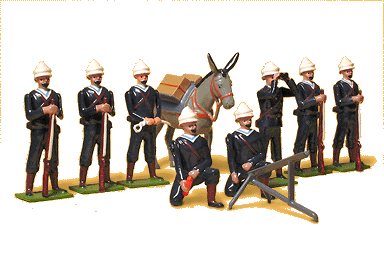 had become precarious: much of Ethiopia was in revolt against him, except for a small area stretching from Lake Tana east to his fortress at Magdala.
had become precarious: much of Ethiopia was in revolt against him, except for a small area stretching from Lake Tana east to his fortress at Magdala.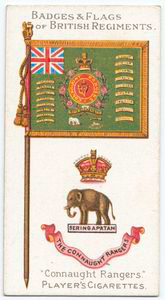 He was engaged in constant military campaigns against a wide array of reb
He was engaged in constant military campaigns against a wide array of reb
els. As a final attempt to recover his standing, Tewodros wrote to the major powers for help. As Donald Crummey recounts, "Now came the definitive
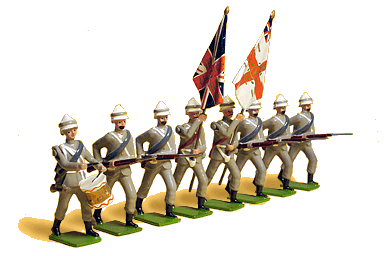 attempt, at the turning point of the Emperor's career. Success might stabilize the internal situation; defeat would pull out the last prop.
attempt, at the turning point of the Emperor's career. Success might stabilize the internal situation; defeat would pull out the last prop. 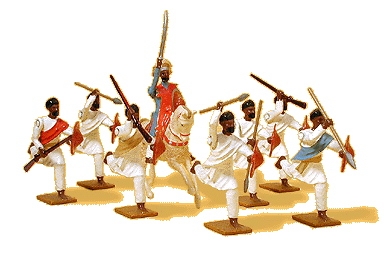
He proposed to send embassies with the ultimate objective of obtaining military alliances and agreements for technical progress.

Tewodros sent letters to Russia, Prussia, Austria, France and Britain. The French government responded with demands on behalf of a Lazarist mission in Hamasien, at the edge of Tewodros' realm; they were the only country known
 to have responded.However, the first European to cross his path after this lack of a response happened to be Henry Stern, a British missionary. Stern had also mentioned the Emperor's humble origins in a book he had published; although the reference was not intended to be insulting ("the eventful and romantic history of the man, who, from a poor boy, in a reed-built convent became...the conqueror of numerous provinces, and the Sovereign of a great and extensive realm") it proved to be a dangerous mist
to have responded.However, the first European to cross his path after this lack of a response happened to be Henry Stern, a British missionary. Stern had also mentioned the Emperor's humble origins in a book he had published; although the reference was not intended to be insulting ("the eventful and romantic history of the man, who, from a poor boy, in a reed-built convent became...the conqueror of numerous provinces, and the Sovereign of a great and extensive realm") it proved to be a dangerous mist ake. At the time Tewodros was insisting on the truth of his descent from the Solomonic dynasty, and Tewodros expressed his rage in many ways, including having Stern's servants beaten to death, and Stern with Rosenthal, were "chained, severely treated, and the latter thrashed on several occasions."
ake. At the time Tewodros was insisting on the truth of his descent from the Solomonic dynasty, and Tewodros expressed his rage in many ways, including having Stern's servants beaten to death, and Stern with Rosenthal, were "chained, severely treated, and the latter thrashed on several occasions."The British consul Charles Duncan Cameron, along with the Abuna Salama and the group of missionaries based at Gafat, all interceded for the release of the imprisoned pair, and for a while it appeared that their efforts might
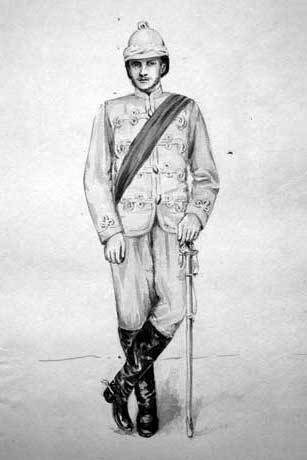 Officer, Abyssinia,
Officer, Abyssinia,  1868
1868succeed; but on 2 January 1864 Cameron was seized along with his staff, and all put in chains. Shortly afterwards, Tewodros ordered most of the Europeans in the royal camp put into chains

The British government sent Hormuzd Rassam, an ethnic Assyrian Christian, to negotiate a solution to this crisis, but "security in Tigre, the King's indecisiveness, and continuing confusion about the envoy's instructions" delayed Rassam's arrival at Tewodros' camp until January 1866. At first, it looked as if Rassam might succeed in the release of the hostages: the Emperor showed him great favour, establishing him at
 Qorata, a village on the south-eastern shores of Lake Tana, and sending him numerous gifts, and having Cameron, Stern, and the other hostages sent to his encampment.
Qorata, a village on the south-eastern shores of Lake Tana, and sending him numerous gifts, and having Cameron, Stern, and the other hostages sent to his encampment.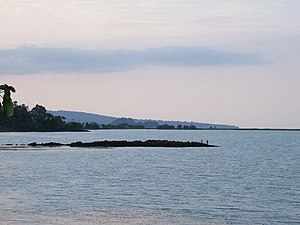 However, about this time C.T. Beke, arrived at Massawa, and forwarded letters from the hostages' families to Tewodros asking for their release. At the least Beke's actions only made Tewodros suspicious. Rassam, writing in his memoirs of the incident, is more direct:
However, about this time C.T. Beke, arrived at Massawa, and forwarded letters from the hostages' families to Tewodros asking for their release. At the least Beke's actions only made Tewodros suspicious. Rassam, writing in his memoirs of the incident, is more direct:  "I date the change in the King's conduct towards me, and the misfortunes which eventually befell the members of the Mission and the old captives, from this day." Meanwhile, Emperor Tewodros' behavior was becoming increasingly erratic, his actions included acts of friendship towards Rassam, paranoid accusations, and sudden violence upon whoever happened to be around him. In the end, Rassam himself was made a prisoner, and one of the missionaries dispatched with the news and Tewodros' latest demands in June 1866. The Emperor eventually moved all of his European prisoners to his fortress on Magdala, and continued to parlay with the British until Queen Victoria announced the decision to send a military expedition to rescue the hostages 21 August 1867.
"I date the change in the King's conduct towards me, and the misfortunes which eventually befell the members of the Mission and the old captives, from this day." Meanwhile, Emperor Tewodros' behavior was becoming increasingly erratic, his actions included acts of friendship towards Rassam, paranoid accusations, and sudden violence upon whoever happened to be around him. In the end, Rassam himself was made a prisoner, and one of the missionaries dispatched with the news and Tewodros' latest demands in June 1866. The Emperor eventually moved all of his European prisoners to his fortress on Magdala, and continued to parlay with the British until Queen Victoria announced the decision to send a military expedition to rescue the hostages 21 August 1867..jpg/330px-21st_Punjab_Regiment_1866_(PRC).jpg)
The campaignIn the eyes of Alan Moorehead, "There has never been in modern times a colonial campaign quite like the British expedition to Ethiopia in 1868. It proceeds from first to last with the decorum and heavy inevitability of a Victorian state banquet, complete with ponderous speeches at the end. And yet it was a fearsome undertaking; for hundreds of years the country had never been invaded, and the savage nature of the terrain alone was enough to promote failure."

The task was given to the Bombay Army, and Lieutenant-General Sir Robert Napie
 r was given command of the expeditionary force. Intelligence was carefully gathered about Ethiopia while the size of the army was calculated and its needs estimated before a massive effort begun to meet them. "Thus, for example, forty-four trained elephants were to be sent from India to carry the heavy guns on the march, while hiring commissions were dispatched all over the Mediterranean and the Near East to obtain mules and camels to handle the lighter gear. A railway, complete with locomotives and some twenty miles (32 km) of track, was to be laid across the coastal plain, and at the landing place large piers, lighthouses and warehouses were to be built." The expedition took Maria Theresa thalers with them to pay local expenses.
r was given command of the expeditionary force. Intelligence was carefully gathered about Ethiopia while the size of the army was calculated and its needs estimated before a massive effort begun to meet them. "Thus, for example, forty-four trained elephants were to be sent from India to carry the heavy guns on the march, while hiring commissions were dispatched all over the Mediterranean and the Near East to obtain mules and camels to handle the lighter gear. A railway, complete with locomotives and some twenty miles (32 km) of track, was to be laid across the coastal plain, and at the landing place large piers, lighthouses and warehouses were to be built." The expedition took Maria Theresa thalers with them to pay local expenses.
The force consisted of 13,000 British and Indian soldiers, 26,000 camp followers and over 40,000 animals, including the elephants. The force set sail from Bombay in upwards of 280 steam and sailing ships. The advance guard of engineers landed at Zula on the Red Sea,
 about 30 miles (48 km) south of Massawa, and began to construct a port in mid-October 1867, and by the end of the first month they had completed a pier, 700 yards (640 m) long; they completed a second one by the first week of December and the railway was already reaching into the interior. At the same time an advance guard, under Sir William Lockyer Merewether, had pushed up the dry bed of the Kumayli River to the Suru Pass, where again the engineers were busy at work building a road to Senafe for the elephants, gun-carriages, and carts.
about 30 miles (48 km) south of Massawa, and began to construct a port in mid-October 1867, and by the end of the first month they had completed a pier, 700 yards (640 m) long; they completed a second one by the first week of December and the railway was already reaching into the interior. At the same time an advance guard, under Sir William Lockyer Merewether, had pushed up the dry bed of the Kumayli River to the Suru Pass, where again the engineers were busy at work building a road to Senafe for the elephants, gun-carriages, and carts.From Senafe, Merewether sent out two letters from Lieutenant-General Napier: one to Emperor Tewodros, demanding the release of the hostages (which Rassam intercepted and destroyed, afraid this ultimatum might enrage Tewodros against the prisoners); the other to the people of Ethiopia, proclaiming that he was there purely to free the captives and that he had hostile intentions only towards those who sought to oppose him. Napier arrived at Zula on 2 January 1868, and put the finishing touches on his plan of advance before leaving on 25 January for Senafe.
It took the British forces 3 months to trek over 400 miles (640 km) of mountainous terrain to the foot of the Emperor's fortress at Magdala. At Antalo, Napier parleyed with Ras Kassai (later Emperor Yohannes IV), and won his support, which the British badly needed in their single-minded march to Magdala; without the help, or at least indifference, of the local peoples, the British Expedition would have never reached its goal deep within the Ethiopian highlands. On 17 March, the army reached Lake Ashangi, 100 miles (160 km) from their goal, and here, to further lighten their loads, the troops were put on half-rations.

At this point, Emperor Tewodros' strength had already been dissolving. At the beginning of 1865 he controlled little more than Begemder, Wadla, and Delanta (wherein the fortress of Magdala lay). He struggled to keep up the size of his army—which Sven Rubenson points out was his only "instrument of power" -- but by mid-1867 defections from his army had reduced its size to 10,000 men. Harold Marcus observes, "For a total cost of about £9,000,000 Napier set out to defeat a man who could muster only a few thousand troops and had long ago ceased to be Ethiopia's leader in anything but title."
The fortress of Magdala burning after the British expeditionary force defeated Tewodros of EthiopiaAt the same time the British marched south to Magdala, Tewodros advanced from the west, up the course of the Bashilo River, with the cannons (including his prize creation, the massive Sebastopol) that he had induced the European missionaries and foreign artisans to build for him at Gafat. The Emperor intended to arrive at Magdala before the British, and although he had a shorter distance to cross and had started his journey ten days before Napier left Zula his success was not certain, and he only arrived at his fortress ten days before his opponents. Rubenson notes that it was Tewodros, not the British expedition, which had to travel through hostile territory, for Tewodros' soldiers
had marched under the threat of attacks from Gobeze's numerically superior forces, and had been obliged to defend themselves against a hostile peasantry. Tewodros's problems of provisioning for his army and transporting his artillery had also been much greater than Napier's. Most important of all, Tewodros could not trust even the four thousand soldiers who still followed him. Given the opportunity, they might abandon him as so many had already done.
Tewodros provided one last demonstration of his lack of diplomatic skills on 17 February, when after accepting the submission of the inhabitants of Delanta, he asked them why they had waited until he appeared with his army. When they answered that they had been prevented by rebellious Oromo and Gobeze, "he told them they were as bad as the others, and ordered them to be plundered. ... Consequently, when the King [Tewodros] further ordered them to be attacked, they all fought bravely, and, in conjunction with the inhabitants of Dawunt, killed a great number of his soldiers and seized their arms and mules." Not only had Tewodros isolated himself for several days in a hostile territory within sight of his last strong hold, a deputation from the Yejju, who were coming to him to offer their submission, upon hearing Tewodros' savagery promptly turned around.
On 9 April, the lead elements of the British force reached the Bashilo, "and on the following morning, Good Friday, they crossed the stream barefooted, stooping to fill their water-bottles on the way."

On the afternoon of that Good Friday, the decisive battle took place outside Magdala, almost as an anti-climax. The British repelled a massive attack, then routed the defending forces in just two hours the following day. British casualties were 2 killed and 18 wounded, while the Ethiopians lost 700 killed and 1,400 wounded.Over the next two days, Tewodros released his European hostages, and on Monday the defeated emperor committed suicide rather than be captured. "When Tewodros preferred self-inflicted death to captivity, he deprived the British of this ultimate satisfaction and laid the foundation for his own resurrection as a symbol of the defiant independence of the Ethiopian."
The British troops begin their return march to ZulaThe British entered the capital and Sir Robert allowed his troops to loot and burn Magdala, including its churches, as a punitive measure, before departing from Ethiopia. His army began to retrace its steps back to Zula, "an imposing procession, with the bands playing and the flags leading the way, but the army soon learned that they had earned no gratitude in Ethiopia; they were treated as simply another warlike tribe on the move, and now that they were going away like weak and defeated men they were an obvious target for attack."At Senafe, the British rewarded Ras Kassai for his services with a formidable quantity of supplies, which Marcus estimates were worth "approximately £500,000": six mortars, six howitzers, about 900 muskets and rifles, stocks of ammunition which included 585,480 percussion caps, and other goods and supplies.These later aided his rise to Emperor, against such talented rivals as Wagshum Gobeze and Menelik of Shewa. By 2 June Napier had reached Zula, and as the men were loaded into the ships, the base camp was dismantled; Napier boarded the Feroze on 10 June, and set sail for England by way of the Suez Canal. In London, Napier was created Baron Napier of Magdala in recognition of his achievement. At Gibraltar, where he served as governor from 1876 to 1883, there is a battery named in his honour, Napier of Magdala Battery
The British expedition took a large amount of treasure, manuscripts and many religious items such as tabots, some of which are in private collections and some of which one can view today in various museums and libraries in Europe. The manuscripts ignited an interest in Ethiopic studies in the West. A few of the items have since been returned to Ethiopia. The most important of these was the crown of Tewodros II, which King George V personally presented to the future Emperor Haile Selassie on his visit to England in 1925
No comments:
Post a Comment